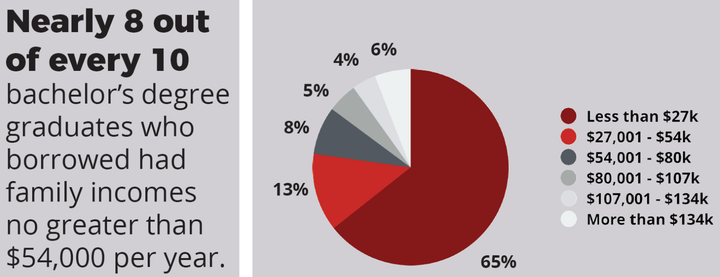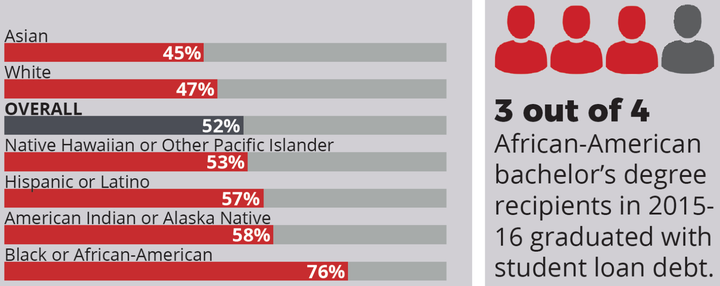This post is co-authored with Maggie White (@Maggie_Blanco), president of the Cal State Student Association (CSSA). She is a graduate student at Stanislaus State University and formerly served on the California State University Board of Trustees.
How far does financial aid get you if you are a poor student living in California? Unfortunately, not as far as you’d think.
Consider this: The State of California spends over $2 billion per year to provide financial aid for hundreds of thousands of college students with the most financial need. In the 23-campus California State University (CSU) system, the majority of the over 400,000 undergraduate students are from low-income families and 80% of all CSU students receive some combination of state, federal, and/or institutional financial aid. As a result, nearly 2 out of 3 CSU students don’t pay tuition at all.
Intuitively, the description of the financial aid system in California might lead you to believe that low-income students are taken care of—they don’t have to worry about tuition, so all is good, right? Not quite.
In fact, the exact opposite is true. Since tuition for Cal State students comprises only about a quarter of the total cost to attend (and as mentioned earlier, the majority of students don’t pay tuition), students are scrambling to cover all of the other expenses like housing, food, textbooks, and transportation, just to name a few. Even after taking their financial aid into account, students would have to work an unreasonable amount of hours to cover the entire cost, so most students have little choice but to take out student loans.
And in a recent report, “Where Debt Comes Due at CSU: Unequal Debt Burdens Among California State University Graduates,” the Cal State Student Association (CSSA) and The Institute for College Access & Success (TICAS) found that despite the seemingly significant amount of financial aid available to Cal State students with the most financial need, student loan debt is concentrated among the lowest-income college grads.
Approximately 90,000 students graduated with a bachelor’s degree from the Cal State system in 2015-16, and over half of them graduated with student loan debt. Of those students who graduated with student loan debt, nearly 8 out of 10 were from family incomes of less than $54,000. And not only were low-income students the majority of those with student loan debt, but their average amount of student loan debt was greater than $16,000 (not tremendously different from the average for higher-income students).

Where Debt Comes Due at CSU: Unequal Debt Burdens Among California State University Graduates
Digging deeper revealed more inequities, this time for students of color. When looking at all 90,000 of the CSU grads in 2015-16, the data showed that students of color were more likely to graduate with student loan debt; but more specifically, three-quarters (76%) of all African-American grads left with student loan debt compared to only 47% of White grads.

Where Debt Comes Due at CSU: Unequal Debt Burdens Among California State University Graduates
So what do these findings mean?
- These findings just confirm that this is the reality for most low-income students in California’s public universities. In the University of California system, the outcomes for low-income students are almost identical: 75% percent of University of California graduates from family incomes less than $53,000 are leaving with an average of almost $20,000 of student loan debt.
- For low-income students, tuition doesn’t seem to be the culprit, but the current financial aid system in California is primarily targeted only at covering tuition costs. Furthermore, the Pell grant—the flagship federal need-based grant that used to cover over 75% of the total cost to attend a public college—has lost significant purchasing power and now doesn’t even cover one-third of the total cost.
- The racial and economic inequities that emerged are troubling to say the least. Jacob Hacker, director of the Yale Institution for Social and Policy Studies, suggests there has been a downward shift of economic risk and responsibility to the Millennial generation, meaning getting a college degree and participating in the economy for young people now come at greater costs/risks. If we extend that line of thinking, apply it to the CSSA/TICAS report discussed here, and view it through an equity lens, it seems that we are disproportionately asking low-income students and students of color to bear the burden of those costs/risks.
Ultimately, we think these findings send some troubling signals about who can really afford a college education, and how state and federal financial aid programs are coming up short in supporting students with the most financial need. If these trends are to be reversed, state and federal policymakers must understand who is being left behind by current policies and practices in order to develop targeted, 21st century solutions for the 21st century college student.
C. Rob Shorette II, Ph.D. is the executive director for the Cal State Student Association (CSSA). You can follow him at @C_Rob Shorette.
